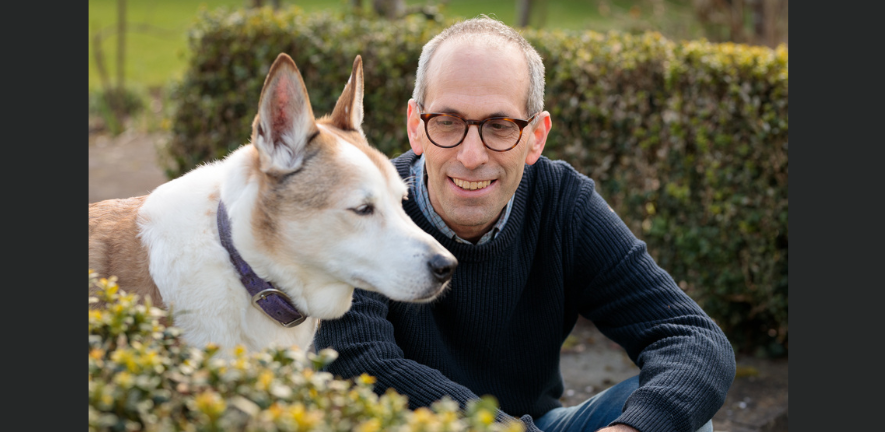
Submitted by Jane Durkin on Mon, 17/10/2022 - 17:00
Arik Kershenbaum is a behavioural ecologist in the Department of Zoology, and Director of Studies at Girton College, University of Cambridge.
He researches vocal communication in animals including wolves, dolphins, whales and hyraxes. He is particularly interested in the role of communication in the evolution of cooperation in intelligent and social species.
His research also covers the search for extra-terrestrial intelligence and xenolinguistics (alien language). He is a member of the international board of advisors for METI.org, a think tank on the topic of Messaging Extra Terrestrial Intelligence, and author of The Zoologist’s Guide to the Galaxy (Penguin Viking, 2020).
Arik will be presenting ‘Could a parrot build a spaceship? Evolutionary constraints on the language of a space-faring species’ at the Cambridge Language Sciences Annual Symposium on 24 November 2022 as part of a research dialogue on 'Exolanguages and communicating with exobeings' with Raymond Hickey.
Twitter: @arikkershenbaum
My research sets out to understand the evolution of complex communication in animals, and what bearing this might have – if any – on the evolution of human language. The main questions I ask are: Just how complex is the information that animals communicate to each other? How do they encode that complexity in their signals? And, why do they need to say that much to each other?
I work in the field mainly with three species: wolves in north America (and a little in Europe too), gibbons in the mountain jungles of Vietnam, and dolphins in Tenerife. I wish most of my time were spent in the field! In reality, though, we might gather data for a few weeks, and then spend months and years sitting in front of a computer analysing those recordings.
Three years ago, I spent two weeks in an isolated cabin, with the outside temperature at -20C, studying wolf vocalisations with a team of mostly early-career researchers. It’s fantastic to see these researchers now moving on to the next stages of their careers and developing their own research directions – this is the best part of research mentoring. Plus, it’s always moving to be in the middle of a snowy forest in the middle of the night, surrounded by howling wolves!
Currently my team and I are working with the cao vit gibbon – one of the rarest mammals in Asia. These gibbons live in an absurdly remote habitat in northern Vietnam and are extremely difficult to study. But they are very vocal. We recently demonstrated that we can pinpoint their locations from their sounds, and we’re working on identifying individuals from their songs as well. That would give a huge boost to the conservationists working to protect the species, by providing a much better indication of how the animals use their habitat.
Out of all my research, I think the project with the most potential to be really ground-breaking is the work I’m doing with colleagues to understand what are the essential units of information in the communication of dolphins. We know that dolphins communicate with continuous whistles, but no one knows how or whether those whistles break down into constituent components. This is an almost impossible question to ask in the case of most species, but with dolphins we have a special advantage: we hope that we will be able to ask them the question directly!
In terms of wider impact, it seems like the only qualitative difference between humans and other animals is that we alone have a true language. So, understanding why that is, really is essential if we want to understand what it means to be human. But more than that, if we are ever to make contact with an alien civilisation, how can we possibly expect to understand their communication, if we don’t even understand the huge diversity of communication that has already evolved on our own planet?
Regarding the theme of this year’s Language Sciences Symposium, language diversity typically refers to the range of different human languages on our planet. But what about languages that surely exist on other planets? It’s not at all clear whether alien languages must follow the rules that govern human language – we don’t even know whether alien languages must be made up of concepts like nouns and verbs. So my interest in the diversity of language – all languages, everywhere in the universe – is a bit broader than usual. And I think that examining non-human animal non-language communication on Earth is a good place to start.
What does language diversity mean for the past, present and future of humankind? Language sets us apart from other creatures on Earth. We think that our language divides us from each other, but in fact it unites us all as being humans. However, we struggle to see the diversity in non-human communication systems, from the gestures of apes, to the whistles of dolphins, to the swirling patterns of colours on the skin of a cuttlefish. Any one of these could be the basis of a true language on an alien planet. Maybe appreciating the diversity of non-human communication will help us respect and protect our fellow Earthlings? Maybe it will help us to embrace rather than fear contact with an alien civilisation, should we ever be lucky enough to make contact.
Photo credit: Arik Kershenbaum with his dog, Darwin, a Canaan dog; photo by Luke Wolagiewicz for Quanta Magazine, originally published in 'Why Extraterrestrial Life May Not Seem Entirely Alien'
